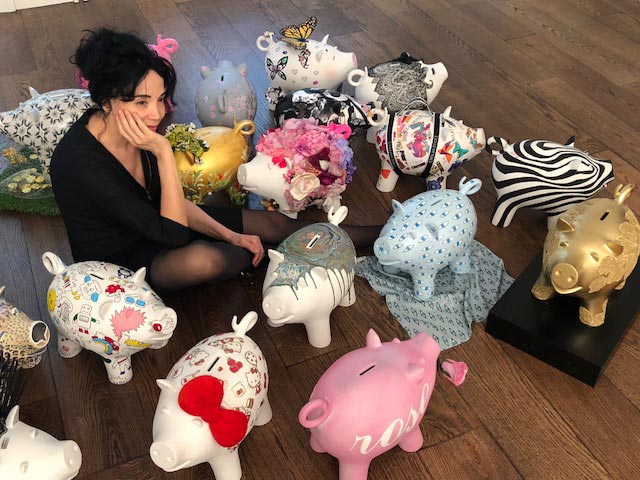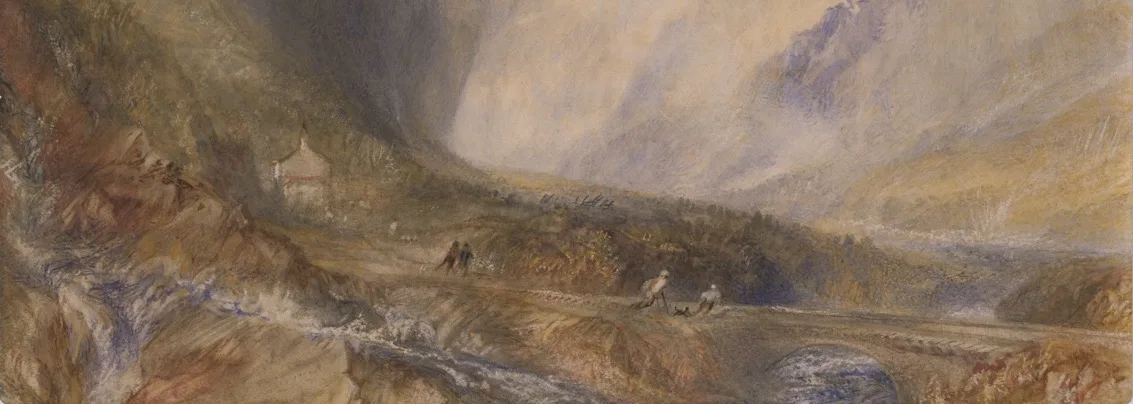A Rebel with a Cause
This past summer, French Lebanese artist Mouna Rebeiz exhibited her second UK solo show ‘The trash-ic. Or trash in the face of beauty’ at the Saatchi Gallery. This exhibition presented the artist’s personal view on current societal issues – each work displayed is not about painting trash as much as it is about painting a period that is “trash”. Not provocative or scandalous for scandal’s sake, but rather an attempt to convey the movement of the times, via the movement of the paintbrush.
Rebeiz uses both the techniques of the Great Masters and applied art. Her work presents many contrasts, throwing up interesting questions and exploring the tension between trash and beauty, and how they coexist as one in art. Our Editor visited the artist at her studio in London for an intimate and candid interview, in which Rebeiz shared her passion for the arts, the secrets of her ever wandering mind, and her sense of purpose.
I-M: I understand you were born into a family of artists and that you were very attracted to the plastic arts since a very young age. Do you remember what made you fall in love with the arts?
M.R: My grandmother was a piano composer. I would say that initially, I loved music and poetry. My grandmother was a piano composer and my uncle is a poet; we have singers in the house, my sisters are interior designers…
Being a painter was unexpected for me. I’ve always loved art but I never wanted to be a painter. I refused the call time and again. I was always good at it, at school I was always top of the class at drawing and painting but for some reason I didn’t want that to be my future.
I-M: You studied Psychology at La Sorbonne, and it wasn’t until 1995, when you joined the Atelier Cépiade in Paris with Alix de la Source, that you really immersed yourself in the study of the arts. Why not earlier?
M.R: It was my sister who really wanted to paint and insisted we looked together for a studio in Paris. I found Atelier Cépiade, and when I met Alix de la Source I agreed to start a course there. At the beginning we did very simple techniques like peinture paysanne, and I didn’t like it, I found it grotesque so I told Alix I wanted to do something more refined. She said: ‘then you have to start painting with oils.’ My first instinct was to refuse but she insisted and brought some roses to paint. I thought that would be impossible but she painted the first one for me and encouraged me to continue. I loved it. I don’t know what happened but I painted as if I knew how, as if I had been using oils all my life.

I-M: Alix de la Source is a specialist of 17th and 18th century painting, and lecturer at the Louvre, I understand that she introduced you to the techniques of the Great Masters and helped you evolve your personal style. How was that journey?
M.R: The moment I accomplished those roses with oils I knew that was it. She told me, “it seems you are going to go far, quickly” and she immediately gave me another assignment, another still life of Yan van Huysum. She made me study the Old Masters and copy their paintings and techniques for a decade. We went to all the big pinacothèques in Paris: the Louvre, the Mussee d’Orsay, Jacquemart-André… all of them. After those 10 years, I was feeling that she had too much influence on me and that I was ready to fly alone.
I wanted to paint on a large scale and she thought it was too poster-like. But when she saw my first “independent” work, she loved it.
I-M: What happened between that moment and your last exhibition, ‘The trash-ic”, which was quite controversial, presenting the dilemma of trash and beauty together and debating how they can cohabit?
M.R: I used to work on a bit of a metaphysical plane. I’d work on misery, and beauty, and pain; intangible concepts so my friends and colleagues criticised my work as not relevant to our times. They constantly asked me to “come down to earth”. I did this for 10 years with the collection Hymne to life. Through women’s body I’d express a wide range of feelings. I consider myself quite a mystic person; I was using figurative art to illustrate abstract concepts.
It was very conceptual, in an abstract base. I actually think that the work of the Great Masters is very conceptual. People in general think that figurative art can’t be conceptual but they are very wrong. If you analyse any painting from Raphael, or Da Vinci for example, they are very conceptually complex.
So at that point, I started to work with Betty Boop. It was my way to come down to earth. I was speaking about virtuality v reality. 9 years ago I had the feeling that we were walking into a very loose era, one in which we’d lose our parameters, one in which everything would be very mixed-up. At the time nobody understood why I picked up Betty Boop to work with. She is very iconic, and she is not real, she is a virtual creation. In the conceptual confrontation I was creating, Betty Boop was virtuality and real women bodies were reality.
I had two shows on this subject. One expressed confrontation and the other one focused on dialogue.

I-M: Your art in general is brave, feminist and provocative. Is this done on purpose to create controversy?
M.R: No, not at all. I don’t do anything on purpose. It is how it comes out of me, it is the cry of the wild (they cry of the heart). For example, after Betty Boop I felt I was ready to express what I wanted and did Le Tarbouche. This is a very universal theme. It is originally from Greece, coloured in Morocco, the fabric comes from Venice and it was embraced by the Ottomans. The tarbouche is worn by men and empowers them, almost like a symbol of virility. I used it on women. The philosopher Elsa Goddard actually posed for me when she was pregnant, completely naked except for the tarbouche. I was inspired by Bernini’s sculpture The Ecstasy of Saint Teresa. The message was a wake up call. Le Tarbouche exhibition in 2015 was my first solo exhibition in London, also at the Saatchi gallery.
After Le Tarbouche I was ready for Trash-ic. I was ready to explore the concepts of trash and beauty together. I started by translating every letter into musical notes and every note into a colour. I did two series of 9 squares. One is very trashy and the other one is much quieter.
For my previous exhibition, La voie de l’opera, from Wagner to Vangelis, Vangelis himself gave me his music, a choral symphony (Mythodia) that he did in collaboration with NASA when they discovered water on planet Mars.

To be honest, only after the Trash-ic exhibition I myself could honestly answer the question “how can they live together?” The answer is: through art, through the act of painting.
It was not about painting trash as much as it was about painting a period that is “trash”. When you paint trash, the beauty and the sublime comes out of it. Painting is an act of magic, capable of bringing out the beautiful dimension of everything, even trash. And so it is that trash and beauty generate/nourish each other, coexisting in the face of controversy and drawing their respective matrixes from a society in search of new points of reference. One no longer exists without the other.
Trash in our society is everywhere, in tv, in social media… we live in a time in which vulgarity is glorified. This affects beauty in a very dangerous way. It distorts minds, it dehumanises us. A human being needs harmony, nature is harmonious, actually the human eye looks for harmony even where there is none, so for example to balance colours, your eyes will always try to see complementary colours together and if they are not there, your eyes will make them up. Art give us back our humanity, art will bring us back to God. Art will save us.
I-M: Who‘d you say is the Master that has inspired you the most?
M.R: I think Goya. Actually I made a version of La Maja Desnuda and one of La Maja Vestida, one more classic, which is in Paris, and one more edgy, which is here in London. Also Hieronymous Bosch, Balthus, and Picasso. These were artists who were not afraid of painting the scandalous, the grotesque, the hardly tolerable, the violent and the beautiful,… all these concepts coexist as one in art. That is the message behind Trash-ic.
I-M: There have been very few recognised female artists in the history of the fine arts. How do you see the situation nowadays? Do you think the world of arts is an even field for men and women?
M.R: No, not at all. Not yet. I am not a feminist but I don’t think there is equality between men and women in the world of art. There is still some prejudice and not recognition enough. However, we women have the ultimate power.
I-M: In your last exhibition you hosted a fundraiser to raise monies for the Charity Innocence In Danger, a world movement for the protection of children against all forms of sexual abuse. How long have you bee involved with this Charity?
M.R: I’ve been involved with this charity for 15 years. Children are sacred to me and we must defend them as they can’t defend themselves. I think that the only time I could kill, it would be for a child.
There is not enough awareness about children abuse, mainly because the abusers hold power and the abused hold none. Children from poor countries are trafficked for all kind of horrific purposes, from sexual trafficking to organ trade. And we call our world civilised?
A specific problem with this cause is that it makes everybody so uncomfortable that nobody wants to speak about it. When you see the things I have seen, what is done to these helpless children, even to babies, you can’t but wonder if God actually exists.
For my last show in London this past summer, I asked renowned designers and artists to apply their individual creative energies to produce unique piggy-banks. Many of those piggy-banks were auctioned by Sotheby’s on the opening night. Participating designers included Chantal Thomas, Christian Lacroix, Caviar House & Prunier, Diane von Furstenberg, Emilio Pucci, Jo Malone, Swarovski, Vangelis, and many more.

I-M: What are you working on at the moment? When will we see another exhibition of Mouna Rebeiz’s works in London?
M.R: I am always painting. I need to, I have to. It is such a primal need. So I have this idea about recycling, that has been playing in my head for the last year or so, and now I have to find a way to express it, to empty my head out. Maybe I will go abstract for this, at least at the moment. It is what my body needs. Abstract is so cleansing!
So at present I need to do more research into materials, technology… I have the feeling that soon we’ll be recycling human beings.

















Show Comments +